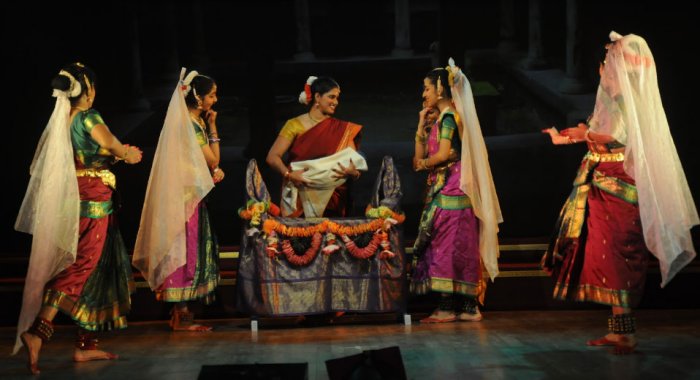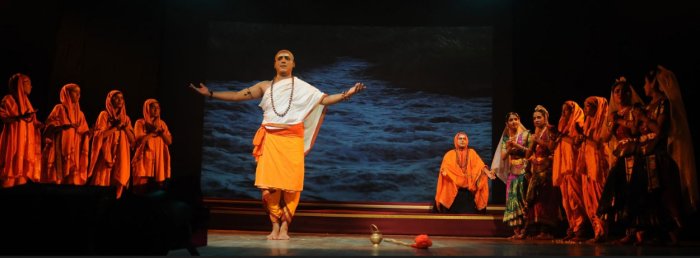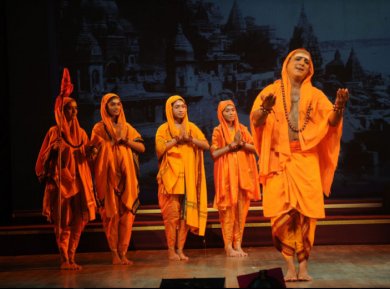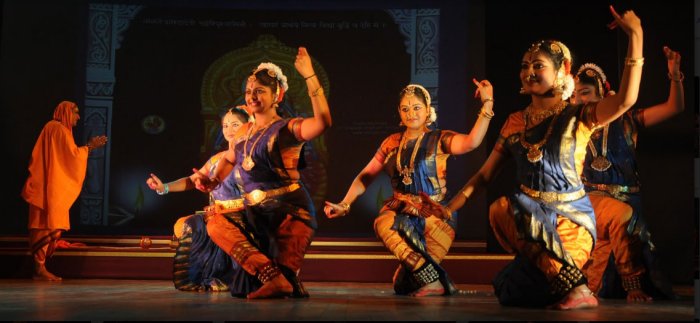
|   |

|   |
Adi Shankara comes alive on stage - G.Ulaganathan e-mail: Ulag_nathh@yahoo.com November 15, 2017 The Keshava Nritya Shala, Bengaluru, celebrated the Keshava Nrityotsava on October 7 with a brilliant dance drama based on the life of Adi Shankara. The show was in the evening and in the morning there was a dance workshop on 'Adaptation of Bharata's Natya Shastra to various classical dance forms.' Among the speakes were gurus Bhanumati (Bharatanatyam), Sharmila Mukerjee (Odissi), Vyjayanti Kashi (Kuchipudi), Nandini Mehta (Kathak) and Prabal Gupta (Kathakali). Ashish Mohan Khokar presided. The dance drama which followed in the evening was Sri Shankara Charitamruta in Kannada and was based on the life of Adi Shankara. It was directed by Guru Shyam Prakash and music was composed by Tirumale Srinivas. Dance choreography was by Vasantalakshmi and Shyam Prakash. Srishuka and R. Chandrika rendered the songs while Srihari played mridangam, and Prasanna Kumar was on rhythm pad. Narasimha Murthy (flute) and Yashaswi (violin) completed the orchestera.   The dance drama begins with a brief background information about Sri Shankaracharya's incarnation. Lord Shiva, Parvati and other dancers are dancing in Kailash. Dancers are happily describing the beauty of Kailash and praising their lord. At that time, some saints arrive there and request Shiva to protect Dharma. Shiva assures them that he would do the needful by taking birth as Shankara. The second scene shows Shiva's incarnation as Shankara and his parents Aaryambe and Shivaguru. His parents happily perform the cradle ceremony and his birth is celebrated with great enthusiasm, dance, music etc.  Then
the story moves on to his Bramhopadesham in the absence of his father
who is no more. Aaryambe seeks permission from the sages to perform
Bramhopadesham and there is a grand celebration. Then the story moves on
when Shankara goes to poor lady Sudati's house for his 'bhiksha'. But
she offers him small gooseberries only because of her poverty. Shankara
sympathises with her situation and composes "Kanakadharastotra", which
causes a rain of golden gooseberries, thus helping Sudati to overcome
her poverty. In scene 5, Shankara seeks his mother's permission to
become a monk. She refuses and convinces him to take up monkhood only
after he gets married and has a family. Later when Shankara takes bath
in a river, he is caught by a crocodile. Seeing this his mother
wails and prays to god to save her son. Then Shankara says, if she
permits him to become a monk, probably the crocodile would set him free.
On hearing this, Aaryambe immediately agrees and grants permission for
him to become a monk. The crocodile frees Shankara when he chants
"peshamantra". Later Shankara consoles his mother and leaves the house
to become a monk. Then
the story moves on to his Bramhopadesham in the absence of his father
who is no more. Aaryambe seeks permission from the sages to perform
Bramhopadesham and there is a grand celebration. Then the story moves on
when Shankara goes to poor lady Sudati's house for his 'bhiksha'. But
she offers him small gooseberries only because of her poverty. Shankara
sympathises with her situation and composes "Kanakadharastotra", which
causes a rain of golden gooseberries, thus helping Sudati to overcome
her poverty. In scene 5, Shankara seeks his mother's permission to
become a monk. She refuses and convinces him to take up monkhood only
after he gets married and has a family. Later when Shankara takes bath
in a river, he is caught by a crocodile. Seeing this his mother
wails and prays to god to save her son. Then Shankara says, if she
permits him to become a monk, probably the crocodile would set him free.
On hearing this, Aaryambe immediately agrees and grants permission for
him to become a monk. The crocodile frees Shankara when he chants
"peshamantra". Later Shankara consoles his mother and leaves the house
to become a monk.Shankara pleads with Guru Govinda Bhagawatpada to accept him as his shishya and help him become a monk. The guru happily obliges and preaches to Shankara about the lifestyle of monks. Shankara is very thankful to his guru and composes "Bhaja Govindam." When river Narmada floods and causes a havoc, Shankara chants certain mantras, fills Narmada in his kamandala and thus stops the flood. His guru is extremely happy about this and motivates him to compose 'Bhashyas' and visit Kashi. Shankaracharya arrives at Varanasi. He composes 'Devi Stuti' when taking a holy bath in River Ganga. Later he composes "Shivanamavalyashtaka" in praise of Lord Kashi Vishwanatha. Shankara then comes across a Chandala. Irritated by his presence, Shankara asks him to move away. But the Chandala asks him, "What should move away? The materialistic body? Or the immortal soul?" This enlightens Shankaracharya and he recognizes that Chandala is none other than Lord Shiva himself and apologizes. He goes to Annapurneshwari temple and composes "Annapurneshwaristotra." Later he meets Vyasa muni, presents his Bhashyas to him andpleads with him to show his original form. Vyasa muni shows himself as Lord Narayana and preaches that there is no difference between Vishnu and Shiva. Then Shankaracharya arrives in Shringeri and establishes Sharada Peeta and composes "Sharada Bhujanga Stotra."In scene 11, Shankaracharya ascends Sarvagna Peeta in Kashmir. The south door of the Sarvagnapeeta in Kashmir has remained closed from a long time as no Pundit from South direction had arrived. When Shankaracharya reaches the Peeta, the scholars belonging to different religions throw a lot of questions at him. When Shankaracharya convinces them with his answers, every one accepts him as the "Sarvagna," the one who knows everything.  This difficult dance drama was presented in a brilliant manner and the bhakti rasa prevailed throughout the two-hour long presentation. Nayana as young Shankaracharya and Raghunandan in dual roles as adult Shankaracharya and Shiva dominated the proceedigns. There was less of dance and more of drama befitting the topic. Costumes and stage props were very appropriate and all the minute details were taken care of. It was like watching a gripping movie on the life of one of our greatest saints. A daring attempt but well executed. G. Ulaganathan is a senior writer and journalist based in Bangalore. |